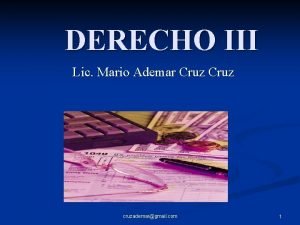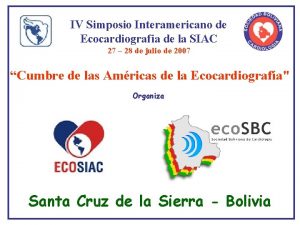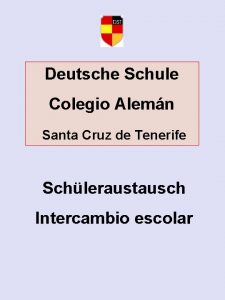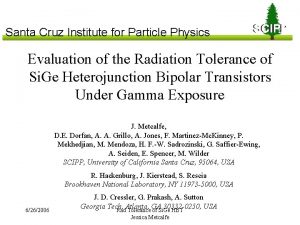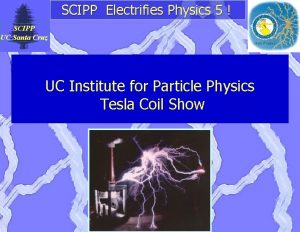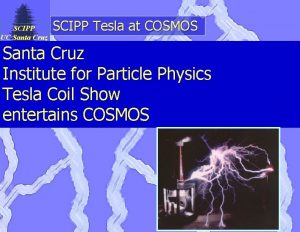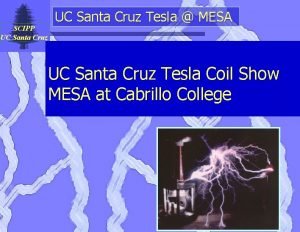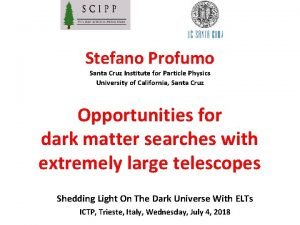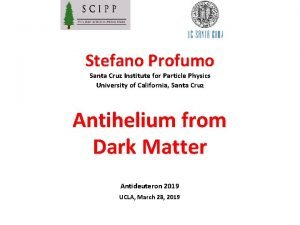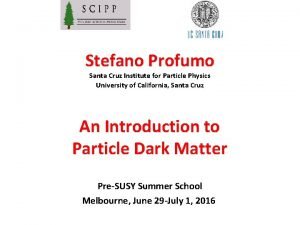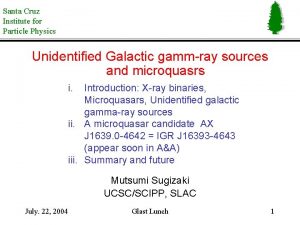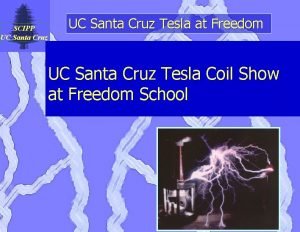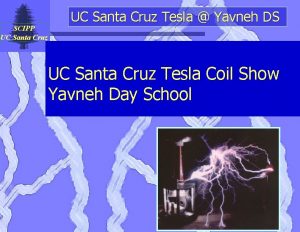Santa Cruz Institute for Particle Physics SCIPP Evaluation
















- Slides: 16

Santa Cruz Institute for Particle Physics SCIPP Evaluation of the Radiation Tolerance of Si. Ge Heterojunction Bipolar Transistors Under Gamma Exposure J. Metcalfe, D. E. Dorfan, A. A. Grillo, A. Jones, F. Martinez-Mc. Kinney, P. Mekhedjian, M. Mendoza, H. F. -W. Sadrozinski, G. Saffier-Ewing, A. Seiden, E. Spencer, M. Wilder SCIPP, University of California Santa Cruz, 95064, USA R. Hackenburg, J. Kierstead, S. Rescia Brookhaven National Laboratory, NY 11973 -5000, USA 6/26/2006 J. D. Cressler, G. Prakash, A. Sutton Georgia Tech, Atlanta, GA 30332 -0250, USA Rad Tolerance of Si. Ge HBT Jessica Metcalfe

Power Constraints SCIPP ATLAS already has over 4, 000 heavy copper cables for the SCT alone! -> Need to reduce power consumption w/out sacrificing noise performance at high radiation levels for ATLAS Upgrade if we want to replace the TRT with silicon. Target for Front-End Channel (Analog Section Only): Current ATLAS: <400 m. W @ 15 p. F (long strips at outer radius, 60 cm) 2 m. W <160 m. W @ 6 p. F (short strips at mid-radius, 20 cm) 6/26/2006 Rad Tolerance of Si. Ge HBT Jessica Metcalfe 2

Why Si. Ge? SCIPP Advantages of Si. Ge Bipolar Over CMOS for Silicon Strip Detectors • A key element in the design of low noise, fast shaping, charge amplifiers is high transconductance in the first stage. • With CMOS technologies, this requires relatively larger bias currents than with bipolar technologies. • The changes that make Si. Ge Bipolar technology operate at 100 GHz for the wireless industry coincide with the features that enhance performance in high energy particle physics applications. • Small feature size increases radiation tolerance. • Extremely small base resistance (of order 10 -100 W) affords low noise designs at very low bias currents. • These design features are important for applications with: • Large capacitive loads (e. g. 5 -15 p. F silicon strip detectors) • Fast shaping times (e. g. accelerator experiments with beam crossing times of tens of nanoseconds in order to identify individual beam crossing events) 6/26/2006 Rad Tolerance of Si. Ge HBT Jessica Metcalfe 3

Si. Ge Technology SCIPP Origin of radiation tolerance: • Small active volume of the transistor • Thin emitter-base spacer oxide (weakest spot) Si. Ge Technology Readily Available • Over 25 foundries • Some Vendors: IBM, IHP, JAZZ, Motorola, STm… IBM offers 3 generations (4 th on the way): IHP Si. Ge Technology: • 5 HP (5 AM): 0. 5 x 1 -> 0. 5 x 20 mm 2 • Radiation Tolerance Study by: • 7 HP: 0. 2 x 1 -> 0. 28 x 20 mm 2 • Miguel Ullán, et al CNM, Barcelona • 8 HP: 0. 12 x 0. 52 -> 0. 12 x 8 mm 2 • Ned Spencer (SCIPP) has designed an amplifier with IHP as a proof of principle 6/26/2006 Rad Tolerance of Si. Ge HBT Jessica Metcalfe 4

Summary of 2004 Proton Results SCIPP Irradiation Procedure: • 5 AM devices were sent to CERN and exposed to a 24 Ge. V proton source with the highest fluence taking 5 days to accumulate. • The leads were grounded during irradiation --> worst case scenario. ATLAS Upgrade Outer Radius Pre-rad 4. 15 x 1013 1. 15 x 1014 3. 50 x 1014 Mid Radius Inner Radius • The transistors were annealed to improve performance. • Special thanks to the RD 50 collaboration, especially, Michael Moll and Maurice Glaser!! Device Sizes: 1. 34 x 1015 3. 58 x 1015 1. 05 x 1016 0. 5 x 1 mm 2 0. 5 x 2. 5 mm 2 0. 5 x 10 mm 2 0. 5 x 20 mm 2 4 x 5 mm 2 6/26/2006 Rad Tolerance of Si. Ge HBT Jessica Metcalfe 5

Summary of 2004 Proton Results SCIPP Current Gain, b, vs. Ic for 0. 5 x 10 mm 2 Pre-rad and for All Fluences Including Full Annealing Lowest Fluence Current Gain, bb Current Gain, Before Irradiation Increasing Fluence Highest Fluence Ic [A] 6/26/2006 Rad Tolerance of Si. Ge HBT Jessica Metcalfe Conclusions: • @ 3 x 1014, Ic low enough for substantial power savings over CMOS • @1 x 1015, Ic good for a front transistor (uses a higher current while minimizing noise) 6

Current Investigation Gamma, Neutron & Proton Irradiations: SCIPP • Over 22, 000 measurements planned!!! • Developed an automatic measuring system at SCIPP and BNL Tests: Measurements: Runs: • 8 HP HBT • Forward Gummel • Characterization (Pre-Rad) • 8 HP HBT--Biased • For gammas & protons • 8 HP HBT--Shield • For gammas & neutrons • Vcb=0 V, 0. 5 V • Post-Rad (No Anneal) • Inverse Gummel • Anneal 1 (5 days @ 25 C) • Vcb=0 V, 0. 5 V • Anneal 2 (1 day @ 60 C) • Early Voltage • Anneal 3 (1 day @ 100 C) • 7 HP HBT • Neutral Base Recombination • 5 AM HBT • M-1, Avalanche Factor • 8 HP Resistor • Resistance • 8 HP Capacitor • Capacitance 6/26/2006 • Anneal 4 (6 days @ 100 C) Rad Tolerance of Si. Ge HBT Jessica Metcalfe ->Plug in a chip, take all measurements for all transistors at once Will this be enough to understand the specific mechanisms for device degradation? ? 7

Current Investigation Characterization measurements: SCIPP Irrad Procedure for Gammas: • 60 Co source at BNL • Measurements performed at BNL • Total dose of 100 Mrads • Devices tested at steps: • 500 k. Rad • 1 Mrad • 5 Mrad • 10 Mrad • 50 Mrad • 100 Mrad • Devices shorted during irrad • Except one 8 HP HBT chip biased • No Shield* (next round) 6/26/2006 Rad Tolerance of Si. Ge HBT Jessica Metcalfe 8

Preliminary Gamma Results SCIPP The damage caused by gammas and protons for comparable doses/fluences is very similar even though starting gain values are different. This may imply that most of the gain degradation is induced by ionization damage. 6/26/2006 Rad Tolerance of Si. Ge HBT Jessica Metcalfe 9

Preliminary Gamma Results SCIPP • 8 HP has the best overall performance. • The damage mechanism in the 7 HP is distinctly different due to structural differences. “ Ionizing radiation has been shown to damage the EB spacer region in these Si. Ge HBTs, and produce a perimeter-dependent space-charge generation/recombination (G/R) base-current leakage component that progressively degrades the base current (and current gain) as the fluence increases. …the 7 HP device degrades much more rapidly than the 5 HP device. This result is consistent with significantly higher EB electric field under the EB spacer region in the 7 HP device, which has both more abrupt doping profiles…as well as a decreased EB spacer thickness compared to the 5 HP device…” Silicon-Germanium Heterojunction Bipolar Transistors, Cressler, Niu 6/26/2006 Rad Tolerance of Si. Ge HBT 10 Jessica Metcalfe

Preliminary Gamma Results SCIPP The gain of the biased 8 HP HBT performs much better after 100 MRads, even though it started at a lower gain value!! The gain of the shorted 8 HP HBT degrades more rapidly after 100 MRads. The gain for the biased transistor started at a lower gain value (normal fluctuation in starting gain), but by 5 MRads showed less radiation damage. At higher doses this effect becomes enhanced indicating that device performance at high doses for transistors shorted during irradiation will be improved. 6/26/2006 Rad Tolerance of Si. Ge HBT Jessica Metcalfe 11

Preliminary Gamma Results: Biased SCIPP Before Irradiation Highest Dose, 100 MRad Biased during irradiation Lowest Dose, 500 k. Rad Transistor performance at for 8 HP at 100 Mrad is very good--the current gain is still 77 at 1 m. A!! (No annealing yet!) 6/26/2006 Rad Tolerance of Si. Ge HBT Jessica Metcalfe 12

Preliminary Gamma Results SCIPP Universal behavior is independent of transistor geometry when compared at the same current density Jc and for similarly shorted or biased transistors. For a given current density D(1/b) scales linearly with the log of the fluence. This precise relation allows the gain after irradiation to be predicted for other Si. Ge HBTs for shorted devices before annealing. Hence, the operating currents can be scaled to desired device sizes for Front-End Channel simulations. 6/26/2006 Rad Tolerance of Si. Ge HBT Jessica Metcalfe 13

Preliminary Gamma Results SCIPP Qualifications for a good transistor: A gain of 50 is a good figure of merit for a transistor to use in a front-end circuit design. Requires only 0. 28 m. A to reach a gain of 50!! At 100 Mrad (before annealing!), the dose reached at the mid-region of ATLAS Upgrade, very small currents can be used in the design of the front transistor and the others in a Front-End Channel design. This provides flexibility in choosing the operating current for the transistor, which allows the FEC design to optimize other factors such as matching. 6/26/2006 Rad Tolerance of Si. Ge HBT Jessica Metcalfe 14

Preliminary Power Savings Pre-Amp Amplifier-Shaper Comparator SCIPP Total 0. 25 mm CMOS 300 m. A (120 m. A)* 210 m. A 120 m. A 1. 5 m. W (1. 1 m. W)* Si. Ge IHP 150 m. A (40 m. A)* 13 m. A 16. 6 m. A 0. 36 m. W (0. 14 m. W)* * Low capacitance (7 p. F) = Short strip FEE Design 360 m. W/Channel SPICE simulations with IHP models predicts these currents yield a Front. End Channel design using only 360 m. W!! Current ATLAS uses 2 m. W! *CMOS numbers courtesy of Kaplon 6/26/2006 Rad Tolerance of Si. Ge HBT Jessica Metcalfe 15

Conclusions SCIPP • Radiation damage may be primarily due to ionization damage. • 8 HP appears to be more Rad Tolerant than 5 AM or 7 HP. • HBTs biased during irradiation (closer to actual conditions in ATLAS) show less damage--interesting to see after annealing. • Preliminary results of gamma irradiations indicate that IBM 8 HP Si. Ge Technology is sufficiently Rad Tolerant for ATLAS Upgrade SCT application. (Irradiations already underway will verify this. ) • May be able to reduce power by 75% from 1500 m. W to 360 m. W! 6/26/2006 Rad Tolerance of Si. Ge HBT Jessica Metcalfe 16
 Mario ademar cruz cruz
Mario ademar cruz cruz Santa cruz community counseling
Santa cruz community counseling Stacy o'farrell santa cruz
Stacy o'farrell santa cruz Siac santa cruz
Siac santa cruz Santa cruz gis
Santa cruz gis Playa azul santa cruz
Playa azul santa cruz Vierge de santa cruz oran
Vierge de santa cruz oran Pinaniniwalaang dumating sa maynila ang sarsuwela noong
Pinaniniwalaang dumating sa maynila ang sarsuwela noong Nicomedes santa cruz poemas meme neguito
Nicomedes santa cruz poemas meme neguito Kaiser permanente santa cruz
Kaiser permanente santa cruz Viksund 340 santa cruz
Viksund 340 santa cruz Rop santa cruz
Rop santa cruz Outcome based accountability
Outcome based accountability Deutsche schule santa cruz
Deutsche schule santa cruz Santa cruz de san saba map
Santa cruz de san saba map Rosario al sagrado corazon de jesus escrito
Rosario al sagrado corazon de jesus escrito Por la señal de la santa cruz
Por la señal de la santa cruz
